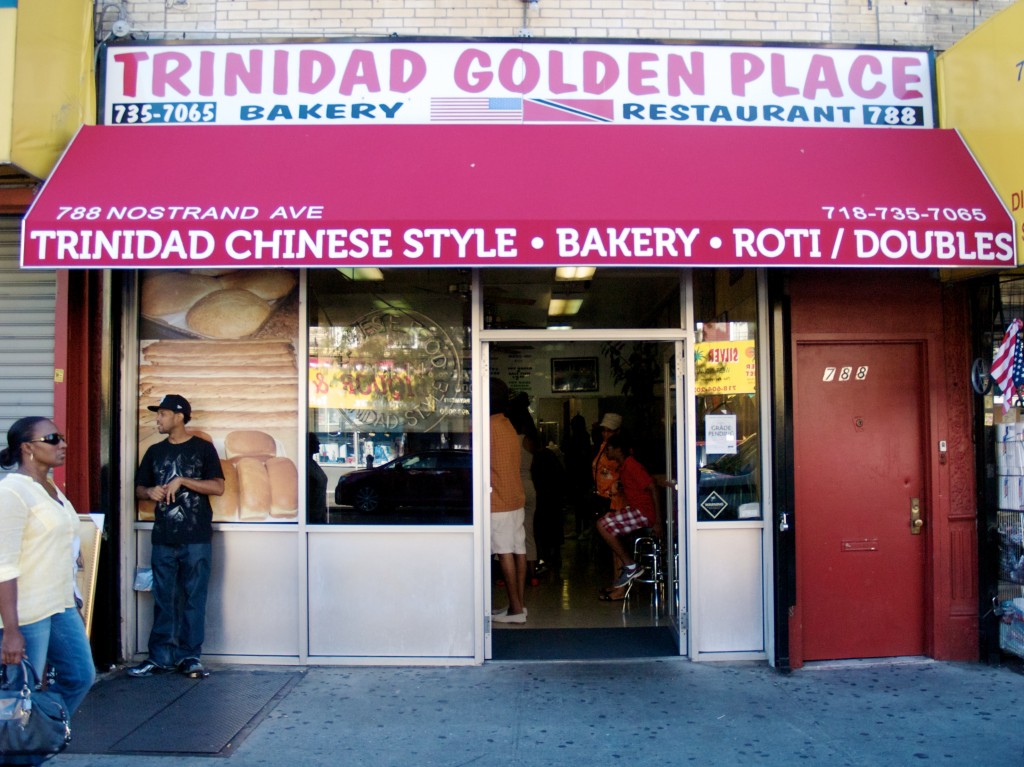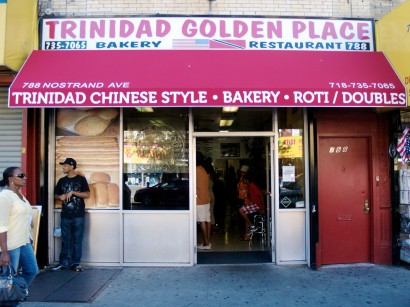This story was written by Aaron Leaf, a freelance journalist based in New York.
Trinidadian “shark and bake”, goat roti and Jamaican jerk are advertised on outdoor signboards along Nostrand Avenue in Crown Heights. Here dozens of restaurants serve Brooklyn’s long-established West Indian community. Even strict Rastafarians have their pick of “Ital” restaurants serving vegetarian food in line with their religious dietary restrictions.
The busiest spot on the strip is Trinidad Golden Place. Lines for this take-out counter stretch out the door until late in the evening. Inside, the menu features Trinidad-style Chinese food, pastries and bread.
On a recent afternoon, patrons were foregoing the Lo Mein for order-after-order of Trinidadian-style roti. These scalding packages contain large portions of curried goat, chicken, shrimp, chickpeas or potato wrapped in a chewy flat-bread. The other big seller on the menu is what owner and chef Wazo, calls his specialty: the currant role. This popular Trinidadian treat contains handfuls of tart currants sitting between buttery layers of hot pastry.
Wazo, a middle aged man with close cropped hair, hurriedly stacks the baguette-sized currant rolls onto baking sheets while a young cook cuts them into pieces the size of cinnamon buns. They’re short handed today and the boss is pitching in where he’s needed. As one tray is filled, more rolls are brought out of the oven. People are buying them as fast as he can make them.
In 2010, Caribbean immigrants made up a third of Brooklyn’s foreign-born population. There are almost 370,000 people of Caribbean background in Brooklyn, about 54,000 of them from Trinidad according to Census figures. Wazo guesses that 85 percent of the customers coming through his doors are Caribbean. It’s his popularity in that community that has kept him in business for fifteen years. But the neighborhood is changing.
“The whole area was much more Caribbean before” he says. Families move away and are displaced by transplanted Manhattanites, but he’s not worried. “All the old customers still come in,” says Wazo.
Trinidad Golden Place features, “home-made Trinidadian style food and all natural ingredients.” All the seasonings, Wazo insists, come from Trinidad. The spices for the curries and and stir-fries he gets from importers, but that’s not enough. Every two months he either goes to Trinidad himself to shop for ingredients or has someone do it for him.
Despite the sign on the awning advertising “Trinidad Chinese food,” Wazo says it’s a misconception to say his food is Chinese. Trinidadian cooking, he says, is a combination of Chinese, Indian and Creole—which itself a mix of European and African influences—and because Trinidad is such a diverse community, people eat it all.
If you’re trying Trinidadian food for the first time, Wazo recommends something small like their “doubles,” a popular snack on the streets of Trinidad and Tobago’s capital, Port of Spain. For a dollar fifty you get a chickpea curry between to fried crepes called “barras” with tamarind chutney and fiery pepper sauce added to your taste. Trinidad Golden Place’s doubles are very large and served hot enough to burn your mouth if you’re not careful.
Wazo is adamant that every curry is different depending on its maker, and he won’t divulge his secret recipe. The following recipe, adapted from TriniGourmet, is a simple place to start making your own unique doubles.
Trinidadian Doubles
Ingredients for the barra:
2 cups flour
1/2 teaspoon salt
1 teaspoon curry powder
1 teaspoon cumin
1/2 teaspoon ground pepper
1 teaspoon yeast
1/3 cup warm water
1/4 teaspoon sugar
Oil for frying
Ingredients for the filling (Curried Chickpeas):
1 14 ounce can of chickpeas
1 tablespoon curry powder
3 cloves garlic, minced
1 onion, sliced
1 tablespoon vegetable oil
2 teaspoon ground cumin
1 teaspoon hot pepper sauce
2 teaspoons salt
1 teaspoon black pepper
Make the barra: In a large bowl combine the flour, salt, curry powder and cumin.
In a separate small bowl place the warm water, sugar and yeast and let sit for 5 minutes.
Add the yeast mixture to the flour mixture and enough water to make a slightly firm dough.
Mix well, cover with a damp cloth and allow to rise for 1 1/2 hours.
The dough should be punched down and allowed to sit for 10 to 15 minutes.
To shape the barra, take 1 tablespoon of the dough and flatten to a round, 4 or 5 inches in diameter.
Use oil to moisten palms of your hands so that the dough won’t stick to them
Fry the barras in hot oil until puffy (about 15 seconds per side), turn once and drain on kitchen paper
When all are cooked, fill with the chickpea mixture (see below) by placing a heaping tablespoon of the cooked filling on each barra, then covering with another to form a sandwich.
Make the filling: Heat the oil in a heavy skillet, add onion, garlic and 1 heaped tablespoon of curry powder mixed with 1/4 cup water.
Sauté for a few minutes.Add the chickpeas, stir to coat well and cook for five minutes.
Add 1 cup water, cumin, salt and pepper; cover, lower heat and simmer until the peas are very soft (20-30 minutes). When the mixture is finished it should be moist and soft.
Add pepper sauce and season to taste with additional salt if desired.
Makes 6 servings
Fi2W is supported by the New York Community Trust and the John S. and James L. Knight Foundation with additional support from the Ralph E. Odgen Foundation and the Sirus Fund.





